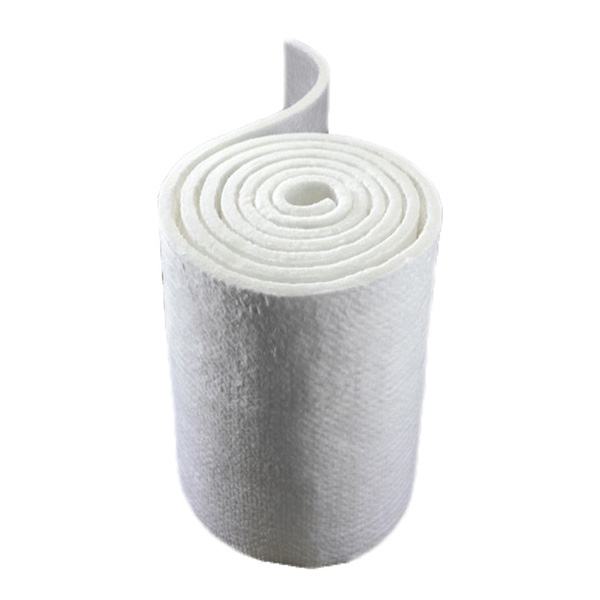| model |
Color |
Minimum order quantity |
Unit size |
EXW price |
FOB price |
Supply capacity |
Packaging form |
| 3mm thick |
white |
20 rolls |
33.4m*1.5m |
210 USD per roll |
236 USD per roll |
500 rolls per day |
bag |
| 6mm thick |
33.4m*1.5m |
236 USD per roll |
264 USD per roll |
| 10mm thick |
16.7m*1.5m |
167 USD per roll |
195 USD per roll |
| 15mm thick |
16.7m*1.5m |
225 USD per roll |
250 USD per roll |
| 20mm thick |
10m*1.5m |
181 USD per roll |
210 USD per roll |
1. Composition and Structure
Main ingredients: The core component of aerogel felt is aerogel. Aerogel is a kind of solid material with nano porous structure, which is usually made of silica and other inorganic substances through special processes such as sol-gel method. In aerogel felts, aerogel particles or fibers are wrapped in the matrix of fiber felts (such as glass fiber felts, ceramic fiber felts, etc.). These fiber felts play a role in supporting the aerogel and enhancing the overall strength of the material.
Structural features: Its unique nano porous structure makes the aerogel felt have extremely low density and high porosity. The size of these pores is usually at the nanometer level, filled with air. This structure gives the aerogel felt excellent thermal insulation performance.
2. Performance characteristics
Super thermal insulation performance: Aerogel felt is one of the materials with the best thermal insulation performance at present. Its thermal conductivity is extremely low, as low as 0.013-0.018W/(m · K) at room temperature, far lower than traditional insulation materials such as rock wool and glass wool. This means that it can effectively prevent heat transfer and be used for insulation in fields such as construction and industrial equipment, greatly reducing heat loss. For example, the use of aerogel felt in the external wall insulation system of buildings can significantly reduce the indoor and outdoor heat exchange compared with other insulation materials, thus reducing energy consumption.
Good temperature resistance: has a wide range of temperature applications. Different types of aerogel felts can withstand different temperatures. Generally speaking, silica aerogel gel felts can maintain stable performance in the temperature range of -200 ℃ -650 ℃. This enables it to provide insulation in both low and high temperature environments, such as in low-temperature storage equipment for cold chain logistics and insulation for high-temperature industrial furnaces.
Excellent fire resistance: Aerogel felt is a non combustible material with high fire resistance rating. In the event of a fire, it can effectively block the spread of flames and does not produce toxic or harmful gases, providing favorable conditions for personnel evacuation and firefighting rescue, greatly improving fire safety.
Light and thin characteristics: the density of aerogel felt is low, and the texture is light and thin. Its thickness is generally around 3-10mm, and compared to other materials with the same insulation performance, it has a smaller volume and lighter weight. This makes it more convenient during the installation process, without causing excessive burden on the building or equipment structure, and also conducive to the effective utilization of space.
Sound absorption and noise reduction function: due to its internal porous structure, the aerogel felt also has the function of sound absorption and noise reduction to a certain extent. Sound undergoes reflection, refraction, and scattering in these pores during propagation, gradually attenuating energy and reducing noise in the environment, creating a quiet space.
3. Application Fields
In the field of building insulation, it is applied to the insulation of exterior walls, roofs, floors and other parts of buildings, which can effectively improve the energy efficiency of buildings, especially suitable for buildings with extremely high insulation requirements, such as passive ultra-low energy buildings.
Industrial insulation field: widely used for insulation of high-temperature equipment and pipelines in chemical, metallurgical, power and other industries. For example, wrapping aerogel felt around high-temperature reactors and steam pipes in petrochemical plants can reduce heat loss and protect the surrounding environment and operators.
Aerospace field: It is also applied in the thermal insulation system of aerospace vehicles. Due to its lightweight and efficient insulation characteristics, it can meet the insulation needs in space environment and help maintain a suitable temperature inside the aircraft.
New energy field: in the battery thermal management system of new energy vehicles, aerogel felt can be used for thermal insulation protection of batteries, to prevent overheating of batteries from causing safety accidents, and also help to improve the working efficiency of batteries.






